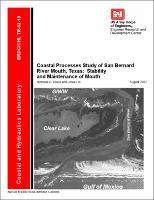Please use this identifier to cite or link to this item:
https://hdl.handle.net/11681/7533Full metadata record
| DC Field | Value | Language |
|---|---|---|
| dc.contributor.author | Kraus, Nicholas C. | - |
| dc.contributor.author | Lin, Lihwa | - |
| dc.date.accessioned | 2016-05-06T14:33:12Z | - |
| dc.date.available | 2016-05-06T14:33:12Z | - |
| dc.date.issued | 2002-08 | - |
| dc.identifier.uri | http://hdl.handle.net/11681/7533 | - |
| dc.description | Technical report | - |
| dc.description | This report documents an investigation of the coastal and inlet physical processes acting at the San Bernard River mouth, Texas. The U.S. Army Engineer District, Galveston, requested the U.S. Army Engineer Research and Development Center (ERDC), Coastal and Hydraulics Laboratory (CHL), to conduct this study to assist in formulation and assessment of alternatives for improving navigation along the Gulf Intracoastal Waterway (GIWW) between the Brazos River and the San Bernard River and vicinity. In recent years, a spit has grown from northeast to southwest across the San Bernard River mouth. The migrating river mouth is narrowing, and sediment shoaling landward of it has reduced the river's discharge to the Gulf of Mexico. Riverflow is diverted into the GIWW, increasing the current velocity in an unpredictable way and possibly increasing sediment shoaling at the intersection of the river and the GIWW, as well as to the east at the west floodgate to the Brazos River. The present study was performed to identify and evaluate alternatives for maintaining the San Bernard River mouth. The San Bernard River is located in north-central Texas and flows through the alluvial valleys of the Colorado River and Brazos River. The central Texas coasts spans several zones from humid in the north to dry subhumid in the south. Average annual rainfall ranges from 104 to 125 cm, with large variations possible between droughts and precipitation brought by tropical storms. The San Bernard River has a much smaller drainage area than either the Colorado River or the Brazos River, with correspondingly much weaker flows and sediment discharge. Therefore, local storms primarily determine its flow. | - |
| dc.publisher | Coastal and Hydraulics Laboratory (U.S) | - |
| dc.publisher | Engineer Research and Development Center (U.S.) | - |
| dc.relation | http://acwc.sdp.sirsi.net/client/en_US/search/asset/1000684 | - |
| dc.relation.ispartofseries | ERDC/CHL TR ; 02-10. | - |
| dc.rights | Approved for public release; distribution is unlimited. | - |
| dc.source | This Digital Resource was created from scans of the Print Resource | - |
| dc.subject | Brazos River (Tex.) | - |
| dc.subject | Ebb-tidal shoal | - |
| dc.subject | Geomorphology | - |
| dc.subject | Numerical model | - |
| dc.subject | River delta | - |
| dc.subject | River mouth | - |
| dc.subject | San Bernard River | - |
| dc.subject | Spit | - |
| dc.subject | Tidal inlet; Texas | - |
| dc.title | Coastal processes study of San Bernard River Mouth, Texas: stability and maintenance of mouth | - |
| dc.type | Report | en_US |
| Appears in Collections: | Technical Report | |
Files in This Item:
| File | Description | Size | Format | |
|---|---|---|---|---|
| CHL-TR-02-10.pdf | 4.38 MB | Adobe PDF |  View/Open |